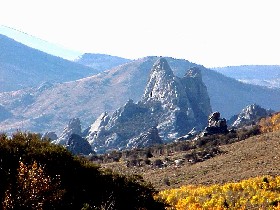"ALMO IDAHO HISTORY!

"We encamped at the City of the Rocks, a noted place from the granite rocks rising abruptly out of the ground. They are in a romantic valley clustered together, which gives them the appearance of a city."
James Wilkins, one of the first wagon travelers through the area, 1849 Cattle dealer James Q Shirley was the first white man to use the Almo area as a home base. In 1869, Shirley and his hired man trailed 13,000 head of Texas longhorns to the area. Here they made camp, raising a garden and utilizing the cove below Graham Peak as a natural corral.
In 1877 arid western lands without irrigation could be claimed under the Desert Land Act. In 1891 the Act was amended requiring that detailed plans for irrigation systems be submitted and that $1 per acre be spend in each of the first three years of development. This labor and money could be shared by communal ditch associations but could not be undertaken on behalf of others.
In the 1880's, the Raft River Valley with its abundant plantings of alfalfa hay became known as the best place in the west to winter sheep. There were free open range privileges and the general area was safe for the bands.
The drought of 1886-1891 and the endless winters of 1882, 1886, and 1889 brought years of overgrazing and brought winter range use to a screeching halt. The old time cowmen reported losses of 50 to 90 per cent during the winter of 1882. The Winecup which branded 38,000 calves in 1885, branded 68 in 1891. The sheep industry was equally devastated.
Forty years after the wagon trains rolled west through the area, Mormon families began to settle in the Raft River Valley. Among the first to arrive were Thomas Edwards, Henry R. Cahoon, Myron B. Durfee, William Jones, and Thomas Owen King, a pony express rider. Followed by Charles Ward, John O. Lowe, and Robert Wake. These settlers claimed the lands along the Almo, Grape, and Edwards creeks. The Cahoon and Durfee families settled along Almo Creek with the intentions of farming. In 1882 Henry Cahoon boasted that they raised 5600 bushels of wheat, oats, and barley and 1500 bushels of potatoes of the best quality. Irrigation systems were developed from springs and creeks.
By 1909 the agricultural zone watered by Circle, Almo, Grape, Edwards, Cassia, and Marsh Basin consisted of almost 12,000 acres of irrigated farmlands surrounding the communities of Almo, Elba, Basin, and Albion. Even then potatoes were an important cash crop and were freighted to the mining communities of Hailey and Boise Basin
In Almo, Elba, and Albion, in 1880, the numerous children were "at school" the women" at home, and the men most often identified themselves as stockmen, farmers and merchants. Most of the settlers were of English or Scandinavian descent. By the turn of the century, Almo boasted a school, post office, and a store. A drama company, and a brass band both traveled to surrounding towns. The three saloons and other undesirable elements had been controlled through the creation of the Village Control Organization.
In 1920, the town of Almo supported 260 "souls" the majority of whom were farmers or stock raisers. The town contained the finest meeting house in the Raft River Stake (a brick replacement for the log meeting house constructed in 1880), a modern schoolhouse, Tracy and Eames General Mercantile, a hotel, a barber shop, a small road-side inn, and a number of fine brick residences.
Weaving carpets to cover floors, making candles, mending shoes, tanning leather, making soap, ironing with irons heated on wood stoves, butchering their own meat, raising gardens, and orchards, cooking, cleaning, nursing, midwifing, and parenting were common tasks performed by the women in helping sustain a livelihood with their husbands.
To supplement their meager incomes, the men would look for other ways which included freighting, hiring out for construction such as at the Oakley Dam, shearing sheep, sugar-beet factory jobs, threshing grain, putting up hay, trapping, selling or trading deer hides.
|
|

